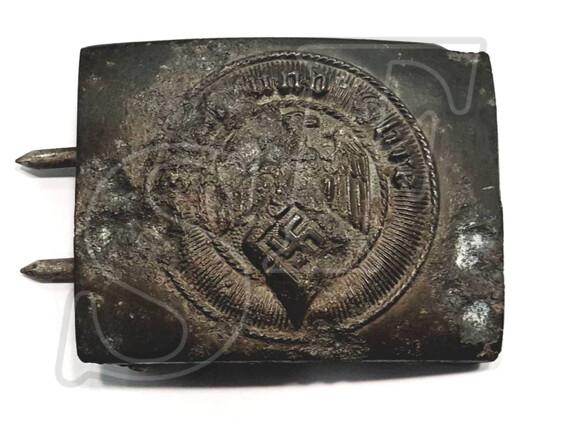Buckle HitlerJugend from Stalingrad
PProduct description: HitlerJugend metal buckle was found at Stalingrad. In good condition mark of quality RZM . For Stalingrad this buckle is rare.
Shipping cost
Shipping cost of small freights (badges, buckles, rings, etc.):
— 10-15 USD by Russian Post
Shipping cost of bulky cargoes (helmets, gas mask canisters etc.):
— 40-55 USD by Russian Post
Buying any product in our store you agree to the rules - please read the rules of the store
Hitler Youth
| Hitlerjugend | |

(Flag of the Hitler Youth)
|
|
| Motto |
|
|---|---|
| Formation | 1933 (1922) |
| Extinction | 1945 |
| Type | Youth organisation |
| Legal status | Defunct, Illegal |
|
Region served
|
Nazi Germany |
| Leader | |
|
Parent organization
|
Nazi Party |
The Hitler Youth (German: ![]() Hitlerjugend (help·info), often abbreviated as HJ in German) was the youth organisation of the Nazi Party in Germany. Its origins dated back to 1922. From 1933 until 1945, it was the sole official youth organisation in Germany and was partially a paramilitary organisation; it was composed of the Hitler Youth proper for male youths aged 14 to 18, the German Youngsters in the Hitler Youth (Deutsches Jungvolk in der Hitler Jugend or "DJ", also "DJV") for younger boys aged 10 to 14, and the League of German Girls (Bund Deutsche Mädel or "BDM").
Hitlerjugend (help·info), often abbreviated as HJ in German) was the youth organisation of the Nazi Party in Germany. Its origins dated back to 1922. From 1933 until 1945, it was the sole official youth organisation in Germany and was partially a paramilitary organisation; it was composed of the Hitler Youth proper for male youths aged 14 to 18, the German Youngsters in the Hitler Youth (Deutsches Jungvolk in der Hitler Jugend or "DJ", also "DJV") for younger boys aged 10 to 14, and the League of German Girls (Bund Deutsche Mädel or "BDM").
With the surrender of Nazi Germany in 1945, the organisation de facto ceased to exist. On 10 October 1945, it was outlawed by the Allied Control Council along with other Nazi Party organisations. Under Section 86 of the Criminal Code of the Federal Republic of Germany, the Hitler Youth is an "unconstitutional organisation" and the distribution or public use of its symbols, except for educational or research purposes, is not permitted.
Origins
In 1922, the Munich-based Nazi Party established its official youth organisation called Jugendbund der NSDAP. It was announced on 8 March 1922 in the Völkischer Beobachter, and its inaugural meeting took place on 13 May the same year. Another youth group was established in 1922 as the ![]() Jungsturm Adolf Hitler (help·info). Based in Munich, Bavaria, it served to train and recruit future members of the Sturmabteilung (SA), the main paramilitary wing of the Nazi Party at that time. One reason the Hitler Youth so easily came into existence stems from the fact that numerous youth movements existed across Germany prior to and especially after World War I. These youth organisations were created for varying purposes; some were religious in disposition and others were ideological, but the more important among them were those formed for political reasons, like the "Young Conservatives" or the "Young Protestants". Once Hitler came onto the revolutionary scene, the transition from seemingly innocuous youth movements to political entities focused on Hitler was swift.
Jungsturm Adolf Hitler (help·info). Based in Munich, Bavaria, it served to train and recruit future members of the Sturmabteilung (SA), the main paramilitary wing of the Nazi Party at that time. One reason the Hitler Youth so easily came into existence stems from the fact that numerous youth movements existed across Germany prior to and especially after World War I. These youth organisations were created for varying purposes; some were religious in disposition and others were ideological, but the more important among them were those formed for political reasons, like the "Young Conservatives" or the "Young Protestants". Once Hitler came onto the revolutionary scene, the transition from seemingly innocuous youth movements to political entities focused on Hitler was swift.
Following the abortive Beer Hall Putsch (in November 1923), the Nazi youth groups ostensibly disbanded, but many elements simply went underground, operating clandestinely in small units under assumed names. In April 1924, the Jugendbund der NSDAP was renamed Grossdeutsche Jugendbewegung (Greater German Youth Movement). On 4 July 1926, the Grossdeutsche Jugendbewegung was officially renamed Hitler Jugend Bund der deutschen Arbeiterjugend (Hitler Youth League of German Worker Youth). This event took place a year after the Nazi Party itself had been reorganised. The architect of the re-organisation was Kurt Gruber, a law student from Plauen in Saxony.
After a short power-struggle with a rival organisation—Gerhard Roßbach's Schilljugend—Gruber prevailed and his "Greater German Youth Movement" became the Nazi Party's official youth organisation. In July 1926, it was renamed Hitler-Jugend, Bund deutscher Arbeiterjugend ("Hitler Youth, League of German Worker Youth") and, for the first time, officially became an integral part of the Sturmabteilung. The name Hitler-Jugend was taken up on the suggestion of Hans Severus Ziegler. By 1930, the Hitlerjugend (HJ) had enlisted over 25,000 boys aged 14 and upwards. They also set up a junior branch, the Deutsches Jungvolk (DJ), for boys aged 10 to 14. Girls from 10 to 18 were given their own parallel organisation, the League of German Girls (BDM).
In April 1932, Chancellor Heinrich Brüning banned the Hitler Youth movement in an attempt to stop widespread political violence. But in June, Brüning's successor as Chancellor, Franz von Papen, lifted the ban as a way of appeasing Hitler, the rapidly ascending political star. A further significant expansion drive started in 1933, after Baldur von Schirach was appointed by Hitler as the first Reichsjugendführer (Reich Youth Leader). All youth organizations were brought under Schirach's control.



